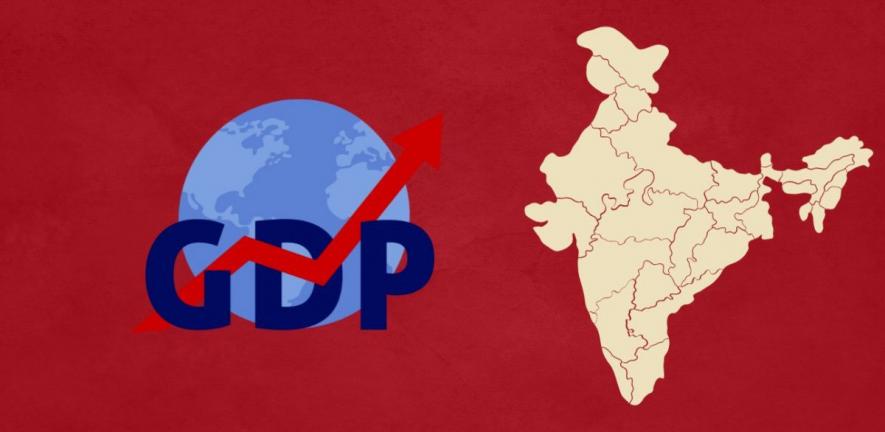GDP Growth: The Gap Between Reality and Rhetoric

Representational Image.
What the true Gross Domestic Product of India is and at what pace it is growing remains in the realm of speculations and contentions.
—
On August 31, the official growth rate of the Indian economy was announced to be 7.8 percent.
The figure immediately came under a lot of criticism by economists and other experts.
The chief economic advisor to the Prime Minister, V. Anantha Nageswaran, and two top officers in the Economic Advisory Council, Dr Bibek Debroy and Aditya Sinha, soon responded to the criticism, implying it is ill-informed.
This reaction was expected since the government has been at pains to claim that the Indian economy is doing well since it is the fastest-growing large economy. Therefore, any criticism of the growth rate dents the government’s credibility.
The arguments
Critics have argued that in the quarterly Gross Domestic Product (GDP) data, there is a category called ‘discrepancy’. Compared to the previous year’s (2022–23) number, its share in the GDP has risen by a staggering 6.2 percent.
The shares of all other categories have declined. Critics point out that this implies the existence of substantial errors in the GDP growth figure of 7.8 percent.
Officials claim that the discrepancy is nothing unusual and not a cause of worry since it gets taken care of over time. The following explanation is offered for its occurrence.
Critics have argued that in the quarterly Gross Domestic Product (GDP) data, there is a category called ‘discrepancy’. Compared to the previous year’s (2022–23) number, its share in the GDP has risen by a staggering 6.2 percent.
There are two ways of measuring GDP, the income and the expenditure methods. The former is taken as the more accurate or dependable figure. So it is suggested that ‘discrepancy’ represents the difference between the figures obtained from the two methods. To bolster the government’s point of view, it is argued that international agencies like the United Nations, the International Monetary Fund and multi-national banks accept the official figures.
The critics are accused of cherry-picking the data. It is stated that when the growth rate turns out to be low, as during the pandemic, then the critics do not raise doubts about it, but the critics point to high unemployment figures to argue that the growth rate cannot be as high as the official data implies.
The officials counter this by pointing to the recent Periodic Labour Force Survey (PLFS) data, which shows an increase in the labour force participation rate in various relevant age groups.
Official methodology
These contending views can only be reconciled by going to the basics of GDP measurement. The official methodology for measuring GDP quarterly can help resolve the conundrum.
The official document spelling out the Methodology of Compiling Quarterly GDP Estimates (July 2017) can help understand the issues. It says:
“Quarterly releases include GDP estimates compiled through production approach (QGDP) and quarterly expenditures of GDP (QGDE) compiled through expenditure approach. The QGDP estimates from the production side is estimated as QGVA at basic prices + net taxes on products.
“The differences between the QGDP estimated by economic activity as QGVA at basic prices plus net taxes on products and the QGDE estimated from the expenditure side is shown as a discrepancy.”
The above quote gives the official definition of discrepancy.
Further, the official document mentions three factors that need to be taken note of regarding the production-side calculation:
- The production approach used for compiling the QGVA estimates is broadly based on the benchmark-indicator method.
- In this method, estimates of Gross Value Added (GVA) are compiled for each of the industry groups.
- In general terms, quarterly estimates of GVA are extrapolations of the annual series of GVA.
These three points clarify that for quarterly GDP estimates using the production approach— which the officials say is the more reliable method— most current data is not available.
Since current data is unavailable, benchmark indicators from an earlier reference year have to be used. Currently, these indicators are very old since recent surveys have not been done.
The shares of all other categories have declined. Critics point out that this implies the existence of substantial errors in the GDP growth figure of 7.8 percent.
In other words, these are dated and do not represent the current reality. Further, the methodology states that extrapolations of the annual series of GVA of previous years obtain current figures.
So, if the previous year’s figures are also incorrect, how can their extrapolation be correct? Finally, in some cases, the procedure adopted is to make annual projections and then divide them by four to give the quarterly figures. So, errors in the previous year’s figures would be reproduced.
Shocks undermine the method
The above methodology relies on a smoothly functioning economy that does not undergo unexpected changes. In other words, it will work only when there is no economic shock.
If there is a shock, then neither will the ‘benchmark indicators’ be valid nor will it be correct to extrapolate from the past.
But the Indian economy has suffered shock after shock since 2016. Demonetisation in 2016 was the first, then in 2017, there was the structurally faulty Goods and Services Tax (GST).
In 2018, the non-banking financial company (NBFC) crisis and, finally, in 2020, the sudden lockdown. These shocks would have impacted the old benchmark indicators, invalidating their use. Each of these shocks differentially impacted the unorganised sector compared to the organised sector, thereby changing their ratios.
Need for fresh surveys
New indicators are required based on fresh surveys. But no new survey of the unorganised sector has been conducted since 2015. Even the census has not been conducted in 2021. So the method used is seriously flawed. Finally, projecting the past annual numbers and dividing by four to get the quarterly figure is also seriously flawed when there is a shock to the economy at some point during the year.
So, not only is the expenditure side in error, as is officially admitted, but even the production approach estimate will give flawed numbers. Under such circumstances, how can the latter be used as a controlling number to calculate the discrepancy? Numbers from both the methods are seriously flawed.
It is not even that the nature of the different shocks was the same. Thus, the impact of each of them on the economy differs. Hence, each has to be separately factored into the calculations.
In other words, errors are getting compounded and reliable GDP numbers are unavailable, especially the quarterly numbers, when the economy has undergone shocks.
Other considerations
The production approach to measuring GDP requires estimating the contribution of the various sectors of the economy. There are nine major sectors which are further broken up into organised and unorganised, and public and private. Each sector and sub-sector requires a separate method. So, 27 different methods are required.
The public sector can be read off from the official data, but that still leaves an estimation of 18 sub-sectors. Each of these is further broken down into different industries and activities.
The official argument that the data from the international agencies support the Indian official numbers is neither here nor there. The international agencies or the RBI do not collect data independently. They use the official data. So, it is unsurprising that their numbers are close to the official numbers. They reproduce the errors in the official data.
For instance, transportation can be via railways, boats, aircraft, rickshaws, push carts and so on. Quarterly data for many of them are not available. That is why projections are required using what is called high-frequency data.
However, most high-frequency data is from the organised sectors and not the unorganised sectors. So, the accurate picture of the economy is not available, given that the data of the unorganised sector is not independently estimated.
The official argument that the data from international agencies support the Indian official numbers is neither here nor there. International agencies or the Reserve Bank of India do not collect data independently. They use the official data. So, it is unsurprising that their numbers are close to the official numbers. They reproduce the errors in the official data.
Further, the criticism that the critics do not say anything when the official GDP growth comes out to be low is incorrect. The same errors are pointed to, and it is argued that the growth rate is even lower than the official projections.
Finally, due to the capital-intensive nature of the organised sector, it only generates a little employment. So its growth, which is what GDP captures, leads to little additional direct employment. Because of poverty and lack of social security, workers have to resort to self-employment, and then they get counted as employed. The system as such is not generating work for them but that does not reflect the reality of unemployment.
Conclusion
To conclude, India’s GDP numbers need to be recalculated with a change in methodology. The argument that the discrepancies get evened out is not a strong one. Discrepancy requires one of the two GDP numbers to be correct. But when both have big errors, what does the discrepancy number stand for?
The criticism that the critics do not say anything when the official GDP growth comes out to be low is incorrect. The same errors are pointed to, and it is argued that the growth rate is even lower than the official projections.
In brief, what the true GDP is and at what pace it is growing remains in the realm of speculations and contentions.
Arguments are based on the author’s book, Indian Economy’s Greatest Crisis: Impact of the Coronavirus and the Road Ahead. 2020
Arun Kumar is a Retired Professor of Economics at the Jawaharlal Nehru University.
Get the latest reports & analysis with people's perspective on Protests, movements & deep analytical videos, discussions of the current affairs in your Telegram app. Subscribe to NewsClick's Telegram channel & get Real-Time updates on stories, as they get published on our website.
























